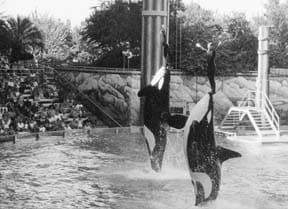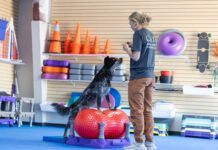Interview by Nancy Kerns
Regular readers of WDJ are aware that we advocate a positive approach to dog training, that is, using only dog-friendly methods to teach our canine companions how we want them to behave in our homes, our cars, our arms – our world. We eschew methods that hurt or frighten dogs, even in the name of the supposed “greater good.” We think there are plenty of dog-related examples to justify this stance, but occasionally, we also find it useful to look beyond the dog-training profession for reinforcement for our beliefs.
The professional animal trainers we interviewed recently offered us tons of substantiating evidence of the efficacy and wisdom of an all-positive training approach – about three tons of affirmation, in fact. That’s the average weight of their most famous pupils – the killer whales who perform at the nation’s SeaWorld parks, and who are trained with all-positive techniques.

Thad Lacinak is vice president and corporate curator of animal training for Anheuser-Busch Entertainment Corporation, parent company of the nation’s SeaWorld and Busch Gardens adventure parks. Lacinak has 30 years of experience working with marine mammals and other animals at SeaWorld’s parks, and oversees all the Busch trainers.
Chuck Tompkins has worked as a SeaWorld trainer with Lacinak for 25 years. Today, he is vice president and curator for SeaWorld, Orlando, and oversees all the SeaWorld trainers at that park.
Lacinak and Tompkins were featured speakers at the Association of Pet Dog Trainers’ annual conference, held recently in Orlando, Florida. Tompkins delivered the keynote presentation on the opening day of the conference; the trainers co-presented a talk about reducing animal aggression on the second day; and on the third day, Lacinak hosted a special presentation for the APDT trainers at SeaWorld.
At these venues, I got to hear the trainers’ positive prescriptions for a wide variety of animal behavior issues, from dealing with serious aggression in carnivorous mammals to introducing a puppy to a family.
After APDT members received a special performance and backstage tour at SeaWorld’s “Shamu Stadium,” I shadowed the duo as they chatted with dog trainers and signed copies of Whale Done: The Power of Positive Relationships, a 2002 book they coauthored with Ken Blanchard, business consultant and author of The One Minute Manager and dozens of other books.
Finally, I had an opportunity to talk to Lacinak and Tompkins about dog training – specifically, positive dog training.
It’s clear that Lacinak and Tompkins have been friends and coworkers for a long time; they playfully interrupt each other and finish each other’s sentences constantly. This can be annoying when talking to people who contradict each other, but the trainers are so clearly on the same wavelength, that they strengthen and support each other’s statements and explanations.
———-
WDJ: Let’s talk about positive training. Tell me why people shouldn’t just smack their dogs when they jump up.
Tompkins: We’ve been training animals for a long time – long enough that we, like most trainers 30 years ago, used to employ both positive and punishment-based training. We’ve seen the pros and cons of both approaches. It’s true; you can get immediate changes in behavior using punishment. Sure; you can get a dog to stop jumping up on you if you smack him. But what else have you done? You’ve torn down your relationship with that dog, and you have shown him that you are aggressive and unpredictable. And none of this is beneficial to the learning process.
Lacinak: Right. Negatives will work. But they also teach the animal to not want to be around you. If he doesn’t want to be around you, how are you going to teach him anything in the future? Think of your best teacher in grade school. The teacher you learned the most from was probably a person you really enjoyed being with. He or she probably kept your interest – not by hurting, scaring, or belittling you – but by making you feel good, by being entertaining, by making the whole process of learning a positive experience. And that’s what you have to do with your dog, or any animal.
Tompkins: Negative training methods cause all animals, humans included, to exhibit a stress response – fight or flight. The chemicals released in the body in this state impede learning and retention . . .
Lacinak: . . . and increase aggression.
WDJ: Speaking of aggression, Chuck, you told a harrowing story in your opening address, about one of the first times you ever got in the water with Ramu, one of SeaWorld’s first killer whale stars. This was way back when you – like most marine mammal trainers then – still used punishment with the whales. What were some of the aversive techniques used back then?
Lacinak: Twenty, thirty years ago, it was pretty standard to take things away from the whales when they weren’t cooperating. This tactic is known in behavioral terms as “negative punishment” – not what popular culture would call punishment.
In its behavioral definition, negative punishment is where an undesired behavior makes “good things” go away; it was widely considered to be quite benign. Say we gave a cue and the whale did not perform the desired behavior; we’d use a tone to signal a warning that he was about to lose something good – food, toys, companions, interaction with us. If he still did not perform at least an approximation of the behavior we wanted, we’d take “the good stuff” away.
We also used positive reinforcement when they did things right. But as we learned more and more, we came to realize that methods like this really do hurt the relationship. And they definitely induce tension and aggression in the animals.
Tompkins: Yeah. One of the first chances he got, Ramu showed us exactly how he felt about having things taken away from him, and how he felt about us.
One of the first times I got in the water with him, he grabbed me by the waist, dragged me to the bottom of the pool, held me down there until I almost passed out, brought me up for a breath – and then did it all over again. He shook me, tossed me around, raced around the pool with me in his mouth. When he had made his point, he literally spit me out onto the deck.
WDJ: Yikes. And the conclusion you drew from this was?
Tompkins: I said to Thad, “Oh my god! This whale hates me!” It hit us both like a ton of bricks. When push came to shove, we had no real relationship with that animal. It was a revelation.
WDJ: And that’s when you decided to try an all-positive training program with the whales instead?
Tompkins: Yes. We realized that if we were ever going to be able to safely get in the water with the whales, we would have to get them to genuinely like us, to build a relationship with them. We had to be able to trust them, and they had to be able to trust us. So, no more punishments.
We went to the boss, a guy who was then the director of training, and said we wanted to try something new. Fortunately, he gave us the time and space to work it out. We immediately stopped all negatives in our training. When Ramu didn’t respond to a cue, or did the wrong thing, we just ignored it. And we kept up all the positive reinforcements for the behaviors we wanted.
WDJ: What happened? Was this successful right away? (Tompkins and Lacinak both laugh.)
Tompkins: Not right away. The whales went on strike for about three days.
Lacinak: Again, in behavioral terms, that’s called an “extinction burst.” They were testing the new program; there were no “Shamu” shows for three days.
Tompkins: (Smiling broadly and waving) “Everything’s fine! This is working! We’re okay! Don’t worry about it!”
WDJ: But it did work, right? You ended up establishing a good relationship with Ramu?
Lacinak: It was a long, hard process, and there were quite a few bumps and bruises along the way. There were a lot of times when he forgot, or when we made mistakes.
What’s amazing is how much better our relationships are with our whales today, the whales who are treated right, right from the very beginning. Training these whales – it’s a piece of cake! They like us, they enjoy training, they offer behavior very freely, they aren’t aggressive.
WDJ: A lot of dog trainers refer to animals like Ramu as their “crossover” dogs – dogs they started with old-fashioned, punishment-based methods, and then switched to positive training when they learned about that. They say the crossover dog is very different from a dog who never experienced punishment.
Lacinak: It’s very hard for an animal to get over being punished. We’ve learned that you just have to make sure you don’t go there in the first place. And it’s hard; I’m not saying it’s easy. But it works; it works with every species, even some of the most aggressive animals in the world.
As we learned with Ramu, large, aggressive animals don’t easily forget or forgive punishment. People get away with punishing dogs because they can; dogs are smaller and so forgiving.
And here’s a cruddy fact: punishment is accepted in society. You’re allowed to smack a dog, you’re allowed to use choke collars, electric collars, all those things. So unless you have a dog who becomes aggressive as a result of punishment – and it happens often enough, we consult on cases like this very frequently – you may get away with it. But you won’t have the best relationship with the animal that you could have.
WDJ: Perhaps you guys are more able to strongly advocate for all-positive training methods, on the strength of the dramatic “fallout” of punishment-based training that you have experienced. It’s dramatic when a dog becomes aggressive, but probably not as sensational as when a killer whale tries to hurt you!
Lacinak: Right. The fallout from punishment is dramatic – but so are the rewards of all-positive training.
WDJ: So let’s talk about that.
Lacinak: Well, you saw some of our animal shows. What did you think?
WDJ: Frankly, I was blown away. I was very impressed with the complexity of the behaviors, of course, but I also really enjoyed seeing the way the trainers are with the animals. They look like they really love the animals; they are so engaged with the animals. They constantly pet, hug, and kiss the animals. They exude positivity. It looks genuine . . . or is that show business?
Lacinak: Well, we are in the entertainment industry; of course we want the trainers to look like they are having fun. But the animation and focused engagement with the animal is also a hugely effective training technique. It’s stimulating and reinforcing to the animal. Marine mammals thrive on that attention.
Tompkins: All animals do. Wives and husbands and kids do, too.
Lacinak: And employees and coworkers. That’s what Whale Done is all about.
WDJ: So, food is not the only reinforcer you use . . . Lacinak: No way! Years ago, all we used was food. But we learned there are many situations where food is not the best . . .
Tompkins: What are you going to do if the animal doesn’t want your food? If that’s all you’ve got to work with, you’re stuck!
Lacinak: For example, we use about 100 different reinforcers with the killer whales. We use different types and amounts of food, yes, but also toys, the opportunity to go play with a buddy, the trainer jumping into the water to play with them. We also keep track of which whales like to be scratched where. They all have favorite spots.
Plus, the opportunity to work with us at all becomes a reward in itself. They want to be with us. At the backstage tour, you probably saw how the whales come right over to the walls of the tank every time a trainer walks by. If they don’t do that, we’re in trouble. Just like if you come home and your dog doesn’t get up and greet you, you have a problem!
Tompkins: A lot of dogs are bored stiff by their owners. Their owners are too predictable, or detached. There is no incentive for the dogs to pay attention to them. Or, if an owner uses punishment when the dog does something wrong, there is actually a disincentive for the dog to get involved with the owner. He stops wanting to even try. But an engaged, fun, non-punishing person invites participation.
Of course, this is true with people, too. A few years ago, after years and years of using positive methods with animals, I realized I needed to use positivity with people, too. I used to be one of those dads who would come home and try to “fix” everything at home. “Hey son! Is your homework done? Then you had better get on it. And pick up your toys while you are at it. Honey, why is the laundry sitting here? And what’s for dinner?” I realized that I had effectively trained my family to see my car in the driveway and be all, “Dad’s home! Run!” Even the dog used to hide when I got home!
That wasn’t what I wanted; I wanted my family to be happy to see me, to greet me at the door. To do this, I had to learn to stop “correcting” everything that I saw that was “wrong,” and instead, start reinforcing all the good things I saw in my family. I had to practice being engaged and enjoyable to my family. Now when I come home, everyone says, “Yay! Dad’s home!” And my dog doesn’t hide anymore, either!
Lacinak: With animals, humans included, you have to be conscious of what you project. We’ve painstakingly taught our trainers to project positive engagement. But it takes practice, it takes time.
Tompkins: It’s funny; people will put lots of time into solving their dog problems, but they rarely put the effort into preventing problems in the first place. It might just take five minutes a day . . .
Lacinak: And thank God, because that way they will always need professional trainers!
Tompkins: But the rewards of doing things the positive way are so great!
Lacinak: It’s more productive, and way more fun. It doesn’t feel good to punish. But it feels great to be able to communicate with and understand another being, to have them want to work and play with you . . .
Tompkins: That’s why we say that success with training is success with relationship-building – no more, no less.




